July 2, 2019
Merriam Park, Hamline-Midway, Como Park
Living in the southwestern part of St. Paul means I almost always have to ride east, north or both, and so it was with this ride to the Como Park neighborhood.

Chair-ity at 1645 Charles Avenue
From the pause at Charles, I moved almost due north along Fry Street until Taylor Avenue, where I was effectively forced to turn. (Fry dead ends half a block north of Taylor because of the limited access to Pierce Butler Route.) Pedaling one block east on Taylor got me to Snelling, one of the busiest and least bike-friendly streets in St. Paul.

Photo courtesy Google Maps
At this spot there are two options: Take the risk of riding north on Snelling a half mile from Taylor over Pierce Butler and two sets of railroad tracks to the off ramp to Como Avenue, all while vehicles whip past at 40 miles per hour or faster. The safer but much longer route is to continue east along Taylor to Hamline Avenue, then go north over multiple railroad tracks to Energy Park Drive, east to Lexington and north to Como Avenue. The disadvantage is, it’s about a mile and a half longer.
Being inherently lazy I chose the Snelling Avenue route, which I regretted almost immediately. It’s an understatement to say that vehicles flying by is disconcerting. I considered taking pictures to better illustrate this but knew the smartest move was to get off Snelling as quickly as I could.

Many windows have been broken out of the back (south) side of the old Sholom Home East building.
After exiting Snelling I continued north a couple of blocks to Canfield Avenue and the former Sholom Home East campus that is in shockingly poor condition. The four-building complex occupies one city block and one of St. Paul’s most visible corners on Snelling Avenue, across from the main entrance of the Minnesota State Fair. Since the building at 1554 Midway Parkway closed in 2009, several plans for redevelopment have fallen through due to lack of funding. Meanwhile, the building falls apart and the grounds deteriorate, victims of neglect and vandalism.

Although the buildings don’t look quite as bad from this angle, the grounds have been ignored.

Clearly this aging sign did little to discourage people from vandalizing the building.

After years of neglect, bushes grow out of control on the west (Snelling Avenue) side of the property. Not a good look for those who go to the State Fair.
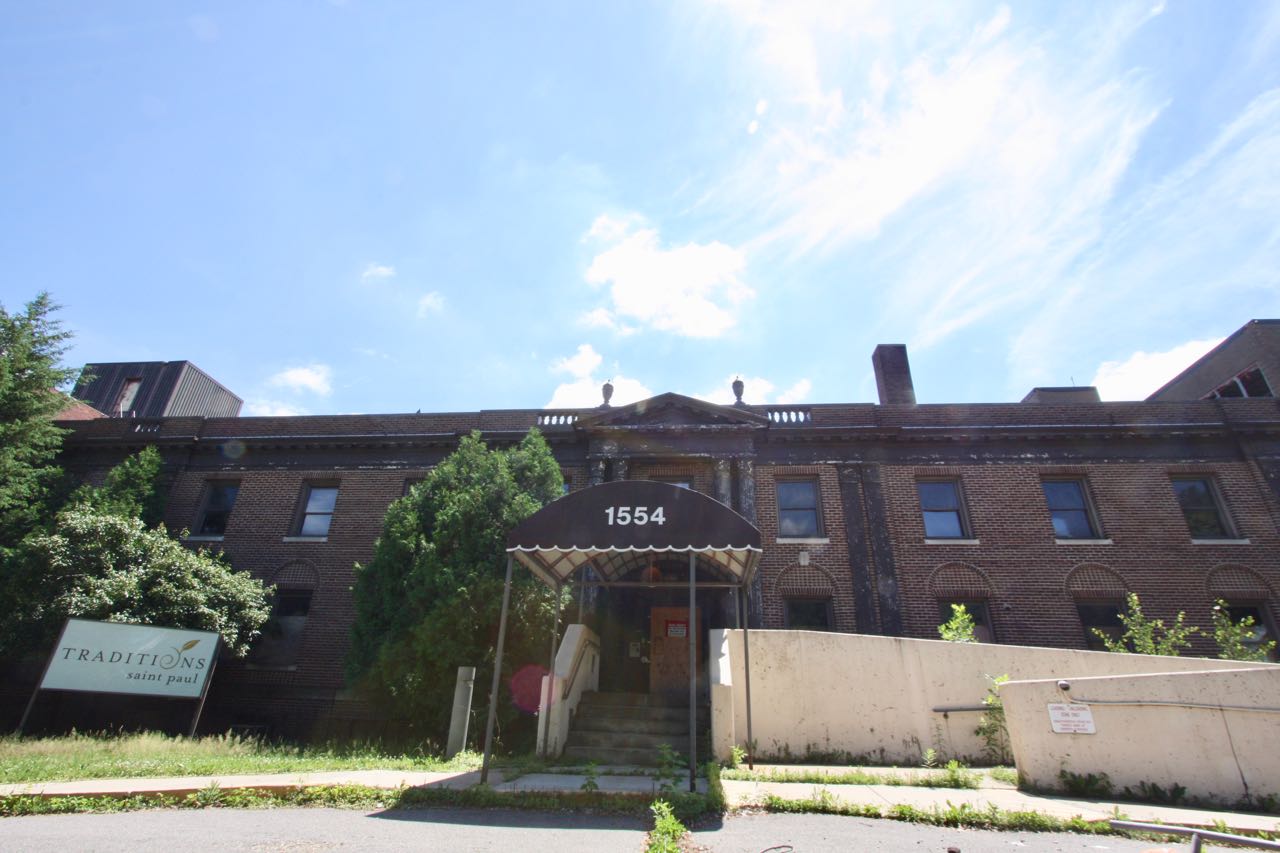
This is the original building, which opened in the early 1920s and was known as the Jewish Home for the Aged.

The original Jewish Home building about 1925: Photo by Norton & Peel. Courtesy Minnesota Historical Society
A couple of nearby streets are peculiarly aligned. McKinley Street is basically a two-block-long thoroughfare, and the northern block is oddly laid out. As you can see below, McKinley actually becomes Holton Street at Arlington going north for 10 feet or so and then reappears to the west. McKinley then diagonally bisects the block bounded by Holton on the east and Pascal to the west.

McKinley runs diagonally between Pascal Street on the west and Holton Street to the east. Courtesy Google Maps

Surprisingly, the block in question of McKinley Street has been a diagonal between Holton and Pascal.
This street alignment resulted in the unusual intersection and signage.

There’s the peculiar double intersections of McKinley Street and Arlington Avenue and Holton and McKinley.
Many of St. Paul’s residential lots, including those in this chunk of Como, are between 40 and 50 feet wide and about 125 feet deep. A couple of the homes here use their lots in unusual ways.
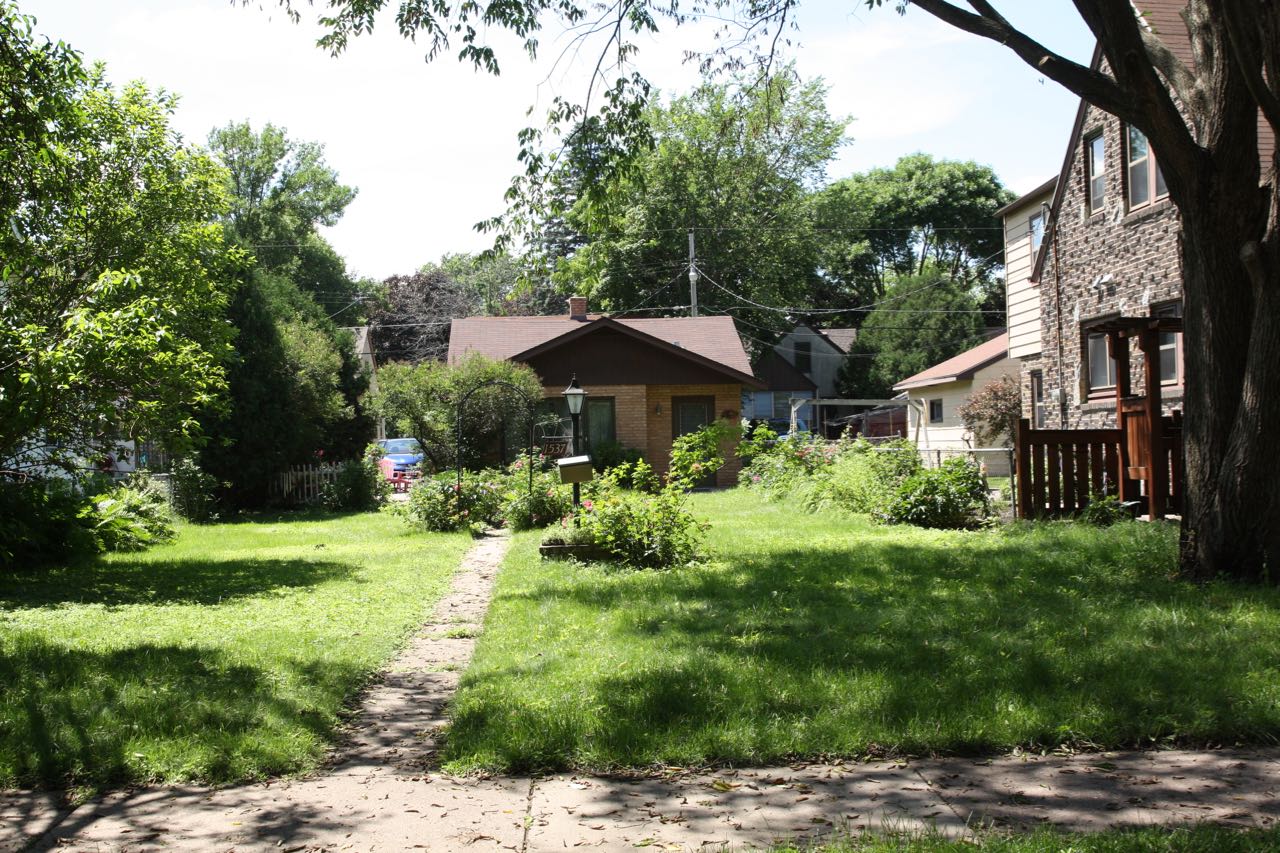
1537 Albert Street is set way back near the alley. Other houses on the block have the more usual placement close to the sidewalk.

From the alley, the unusual placement of 1537 Albert is clear. The blue car was sitting in the driveway.

The house at 1529 Sheldon Street is in a very similar spot on the lot.
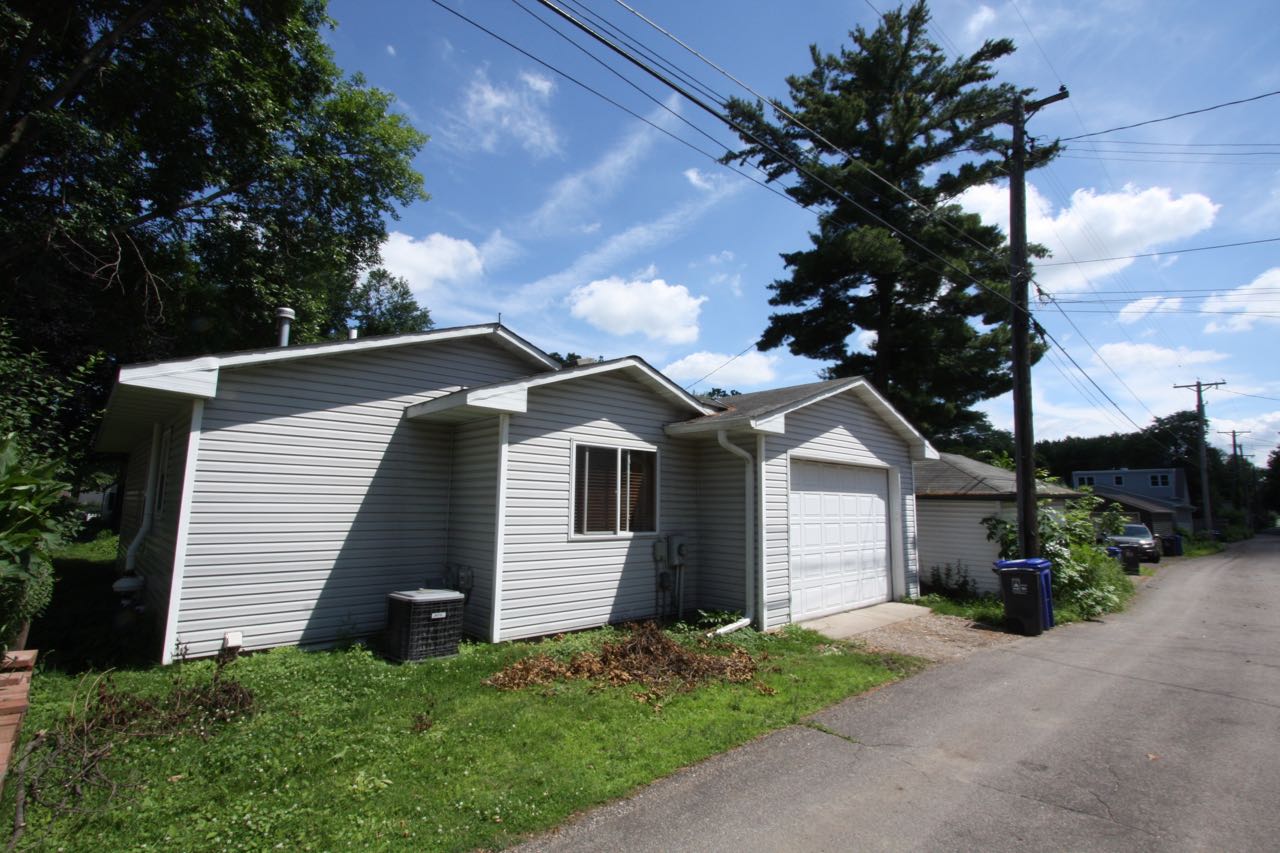
1529 Sheldon abuts the alley much like the Albert Street house.

The Victorian home and its gravel driveway and large lot at 1371 Nebraska Avenue
There is nothing like an unanticipated discovery. Today it was seeing the copula-capped Victorian house on Nebraska Avenue at Sheldon Street. Oriented with its front porch and entrance facing the east rather than Nebraska Avenue like neighboring homes, 1371 Nebraska — best known as the George H. and Hannah Hazzard house for its original occupants — was built about 1870. With its semicircular gravel driveway, large lot, and abundant trees and bushes, the homestead made me feel as if I had been transported to a country farmstead.

The front porch and entrance to 1371 Nebraska, on the left, face the side of 1359 Nebraska, on the right.
Circumstantial evidence suggests the front yard once went all the way to Hamline Avenue, a plausible explanation for its east-facing entrance. Plat maps available online don’t confirm this, but I found a late 18th century reference to the home’s address being 1511 Hamline Avenue North.

The three properties to the east of 1371 Nebraska: Hamline Avenue is on the opposite side of the building with the red awnings.
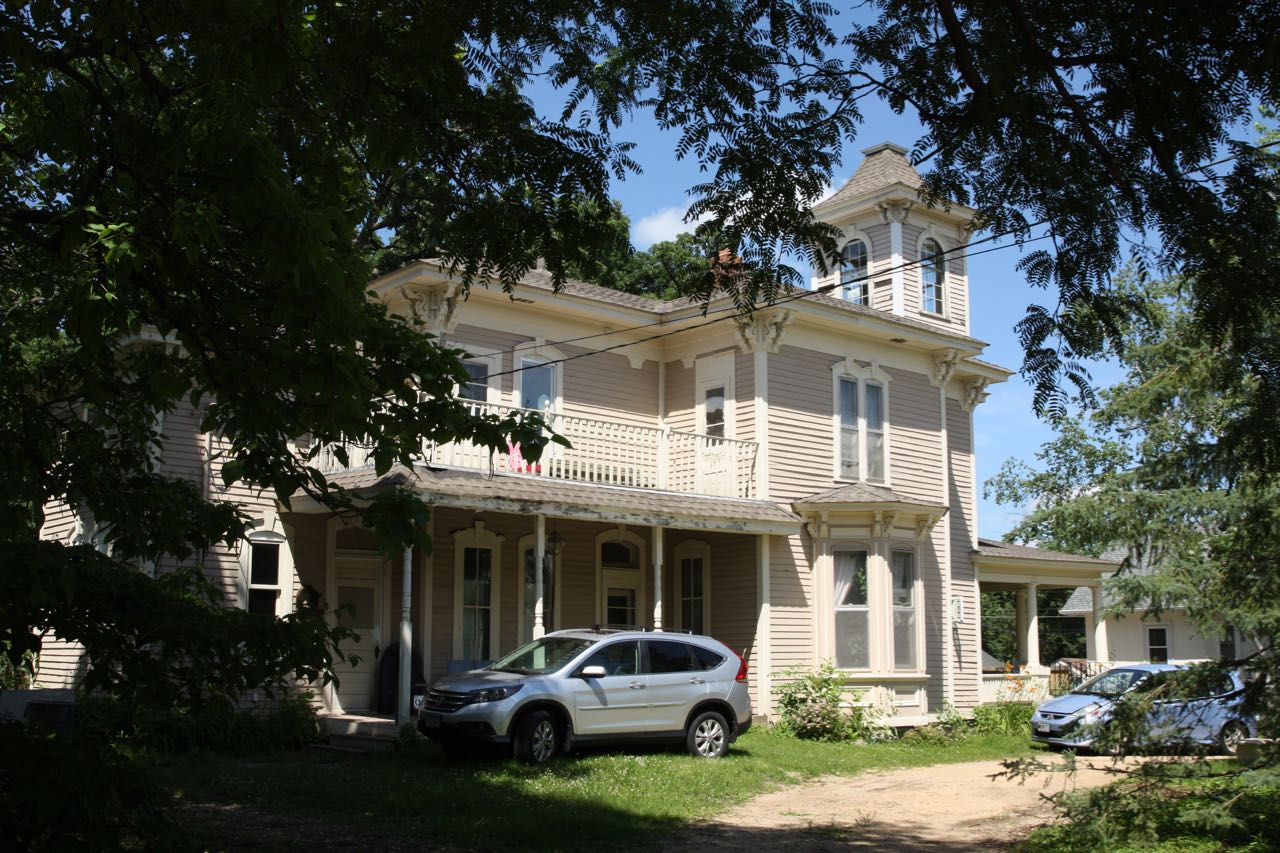
The south side of the house, facing Nebraska Avenue
The property and the Hazzards have a long and fascinating history. Accounts differ as to whether Hannah (Hoyt) Hazzard and George Hazzard were given the 10-acre property by Hannah’s brother, Lorenzo Hoyt, as a wedding gift or if they purchased it from him. No matter, George and Hannah Hazzard had the Italianate-style house built in the early 1870s. At that time the house had neither electricity nor indoor plumbing. (Later residents added both conveniences to the home in the early 1900s, long after Hannah and George had moved out.)

The cupola was an original feature of the Hazzard home and remained at least into 1910. Photo courtesy Minnesota Historical Society

For many years the home was without the cupola. The Park Bugle newspaper says Ron Dorumsgaard built a replacement cupola in 2004. Photo courtesy Minnesota Historical Society
After the Hazzards sold the home, it changed hands several times through 1950, according to the May 1991 Park Bugle newspaper. Como Presbyterian Church bought the home in 1950 and used it until 1958, when it was sold again. About 1951 the Hazzard home was split into a duplex and gradually deteriorated. And so it went until 1986 when, according to the Park Bugle, Ron Dorumsgaard and his mother purchased the property. They returned the Hazzard home to its original glory, ultimately turning the Victorian beauty into the Como Villa bed and breakfast. Information is sparse, but some years later, Como Villa closed and the home was again sold.
As for Hannah (Hoyt) Hazzard, she and her brother, Lorenzo, were part of the influential early St. Paul Hoyt family, from which Hoyt Avenue draws its name. Their father, Benjamin Hoyt, was a Methodist minister, one of the founders of Hamline University and a prolific investor in real estate.

George H. Hazzard in 1889: Photo courtesy Minnesota Historical Society
George Hazzard, meanwhile, had a far less comfortable upbringing than his bride. After the death of George’s father when George was 4, his mother raised him and his two sisters. The family moved to Winona, then the Taylors Falls area, where George formed a deep love of the Dalles of the St. Croix. Several years later they relocated to St. Paul, where George found success unloading barges.
As a Ramsey County commissioner he led the effort to create a permanent spot for the Minnesota State Fairgrounds on what was the county’s Poor Farm.
Hazzard’s lobbying efforts resulted in the creation of Interstate State Park in both Minnesota in 1895 and Wisconsin in 1900, protecting in perpetuity his beloved Dalles of the St. Croix from development. Interstate State Park was the first in the nation operated by two states.
Back on the street, Sheldon Street to be precise, was a garden loom, something unknown to me prior to this stop.

The Sheldon Street Garden Loom: an interesting but apparently underused diversion at 1474 Sheldon

A project using cloth and vines had been started.
I continued the journey south on Sheldon, which ended at Frankson Avenue. Taking a right on Frankson I almost immediately came upon a grand fence that framed a luxuriously landscaped yard.

I’ve included many gardens in the blog because of the nearly endless variety, style and quality of the plots. From the sidewalk the view of this yard at Frankson and Hamline was even more splendid, bursting with color from dozens of flowers precisely placed in gardens and pots around the yard.

Another look at 1359 Hamline from Frankson Avenue
Marcus Phelps-Munson was playing with his dog, Nina, as I peered through the fence. I complimented him on the garden, and we chatted for a few moments before he invited me in for a tour.

Marcus Phelps-Munson and Nina spend a lot of time playing and working in their lavish backyard.

Gary Epperley enjoys a glass of wine in the yard he and Marcus meticulously attend to. Photo courtesy Marcus Phelps-Munson
Marcus and his husband, Gary Epperley, moved from Sammamish, Washington, near Seattle, to 1359 Hamline Avenue (at Frankson) in the winter of 2017, when Gary took a job at 3M.
Not surprisingly, Marcus said the cold winter is the biggest difference between Washington and Minnesota. Gardening here is another thing to which he and Gary are adjusting. “We needed to live through it for a year to see what was there (in the yard.) This year we’re slowly doing some things,” Marcus said.
“There was arborvitae all around the perimeter (of the yard.) But a dog does not respect arborvitae, especially on a main road where people go biking by or walking by with all their dogs. She would want to run out and say hello to everyone.”

Marcus solved the problem by designing a wooden fence with alternating panels of solid and lattice, which replaced the arborvitae in September 2018. “This allows us to be out here and, just like when you went by, interact with the neighborhood, still be in our yard, but be able to talk and invite people up.”
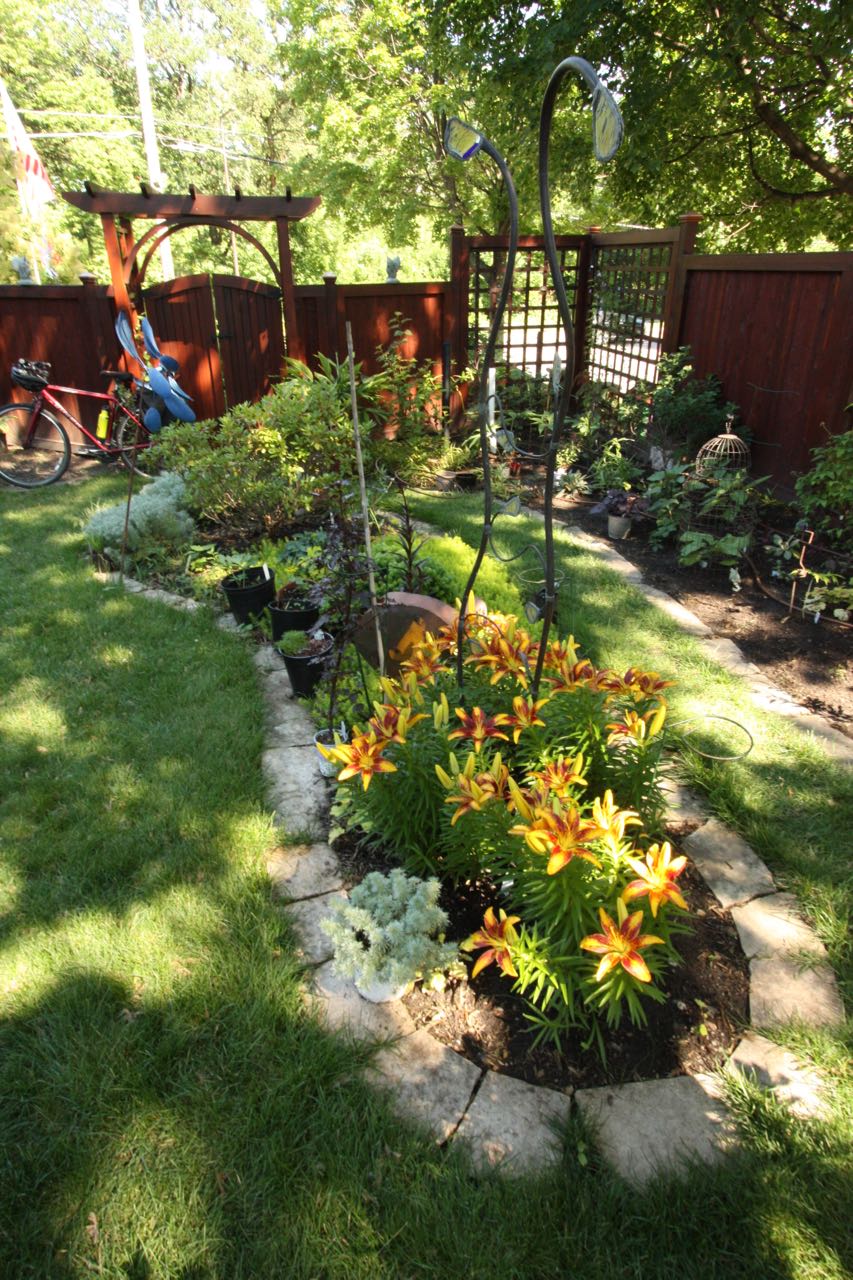
Lilies that Marcus and Gary relocated to another garden
“I love the neighborhood,” continued Marcus. “The people here are even friendlier than they were out in Washington, which is nice. Gardening was a little easier out there, and I’m learning what you can grow and what you can’t grow.”
Marcus likes to push boundaries with his gardening. “I’ve always had a certain amount of zonal denial. We’ll try to grow things here that you can’t. A lot of the older homes have a small sunroom that is part of the house. I utilize that room to overwinter a lot of different things and started some seeds in there, too.”

Gary and Marcus have a four-car garage, which Marcus called “perfect for parking both of our cars as well as pots, potting soil and overwintering plants.”
“We have some large purple datura and brugmansias that I’ve started from seed,” Marcus explained. “I collected those brugmansia seeds when we went to France last year. We stopped at a park, and in that park was a beautiful brugmansia plant that had some seed pods hanging off of it. So I collected a seed pod. I started those seeds this year, and the plants are out here.”

Gary and Marcus brought these bergenia or “pigsqueak” plants with them from Washington.
One of the plants that Marcus and Gary brought from Washington is bergenia. “Its common name is pigsqueak because when the leaves rub against one another they sort of squeak. This variegated version we found when we were out plant hunting when we lived in Washington state,” Marcus said.
“A lot of times when I get plants, I will leave them in their pots and move them around prior to planting. It’s so much easier to move it when it’s still in the pot. So I get a feel for where it wants to be. It lets me know if it’s happy there. You listen to the plants, they’ll tell you.”
Marcus strives to layer plants from front to back, with plants of differing heights, and to maximize blooms throughout the growing season.


A major draw for Gary and Marcus is their location across Hamline Avenue from Como Park. It didn’t take Marcus long to discover the Como Conservatory, from which he’s gotten plants. “They periodically will sell different plants that they’re getting rid of. They have a really nice bromeliad collection that they tend to thin out in the winter. They’ve grown beautifully, and naturally they spend the winter inside. Some people like to summer on the coast. Well, the plants summer out here on the patio.”

A corner of the gardens next to the garage is dedicated to veggies.

The Wolf Woods at Como Zoo is across Hamline Avenue and behind the line of trees. The photo was taken in the front yard of Marcus and Gary’s house.
Despite the proximity of their house to Como Park and Zoo, Marcus and Gary rarely hear much from either. “We do hear the occasional sound from the amusement park. Sometimes you’ll hear the kids squealing,” said Marcus, “which is kind of nice.”
“In winter if I’m out here, I will hear people taunting the wolves because the wolf enclosure is directly across. In fact, we can see them from our living room in the winter because the trees have dropped their leaves.”
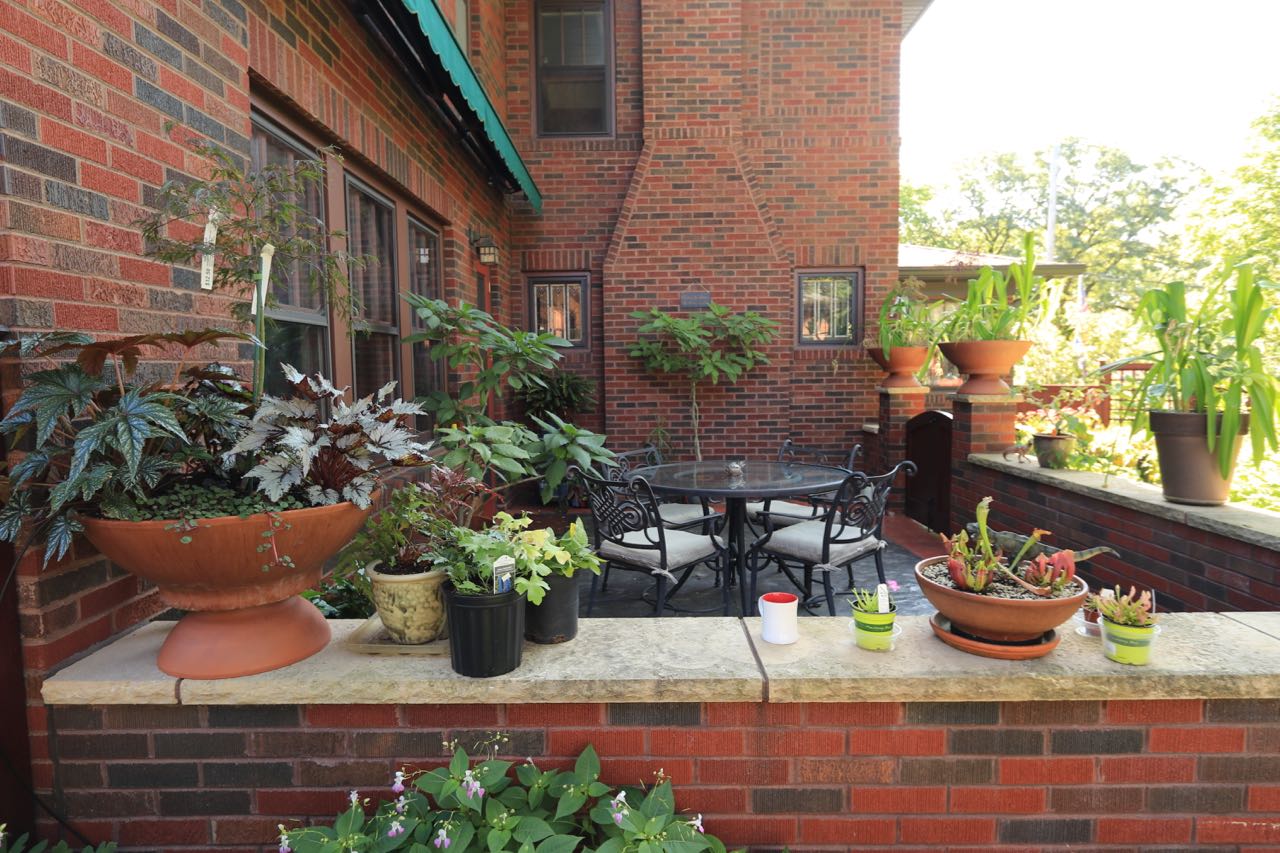
Planters with many varieties of foliage decorate the patio.
During the heart of summer, when I visited, the yard was more about work than leisure, according to Marcus. “Once we get things a bit more established and down, then yes, we’ll spend more time on the patio.” But he added, “Sundays, we open a bottle of wine and we’ll sit out here on the swinging bench and enjoy the area, talk with people as they go by.”
Marcus’ first gardening memory is from when he was about 5 and living in West Palm Beach, Florida. “I wanted to put a little garden in the backyard, and I dug out a small patch of dirt back there,” he recalled. “I remember that I had planted lima beans up against a cyclone fence that the neighbor had, so it was perfect for lima beans to climb on, and they did very well. I have no idea why I planted lima beans because it’s one of the few things I really don’t like!”
Gary and Marcus have added a touch of frivolity to their garden — in the form of dinosaurs.

Two dinosaurs look at home among the ferns in this garden.

A Tyrannosaurus rex and some Sarracenia Scarlet Belle plants, both carnivores, share a planter.
The dinosaurs started by accident about 12 years ago. As Marcus explained it, he and Gary stopped at an old-style drugstore on a trip to one of the islands off the Washington coast. “They had this fantastic, heavy-duty quality dinosaur. So I bought that, and I thought it just looked wonderful in the garden.” Since then, on their yearly vacation, he or Gary will add another dinosaur to the herd.
Marcus has plans to enhance the already amazing garden. “I would love to put in a small pond feature or waterfall.” He has contemplated putting boulders at the corner of the garage, “and then some bricks, having them sort of splay out, intermixed with the boulders. So it looks like over eons and centuries the boulders were taking back the area and just pushing out from the garage.”

The front of Marcus and Gary’s home at 1359 Hamline
Marcus and I exchanged a couple of emails after our July 2 meeting. He kindly set aside three plants for me, and I am pleased to say that all three are doing well (thanks to my wife’s green thumb).
Note: Though I usually post a link to the map of the ride, the GPS recording is unavailable. I am in the process of recreating the route and will add it later.
